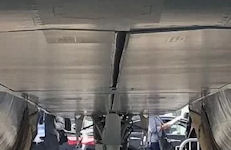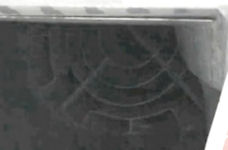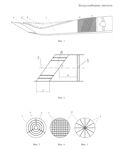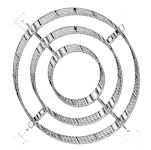Su-57 Felon - Stealth
Wang Yongqing, chief designer of China's Shenyang Aircraft Design Institute, wrote in Aerospace Knowledge magazine in February 2019 that while the Su-57's super-maneuverability and supercruise capabilities were impressive, these had been so emphasized at the expense of its stealth capabilities that it was questionable whether or not the jet could really be called "stealthy."
Western analysts often cited the poor cosmetics and crude surface finishes of Soviet weapon components as an example of the poor quality of Soviet workmanship. In fact, the lack of polish on Soviet machine surfaces was a deliberate trade-off to increase producibility of parts. Tight tolerances and high-grade surface finishes were generally restricted to areas where they are functionally required, but for stealth aircraft, these tolorances are required on all external surfaces. The Soviet state standards for machine tools generally specified a lower level of accuracy to be built into their machines than are built into their Western counterparts, which resulted in a lower tolerance capability on the factory floor.
The new Russian fighter has significantly reduced the effective scattering surface (EPR) - the main characteristic of the aircraft visibility in the radar field. The average value of this indicator in the T-50 is 0.3-0.4 m². It must be borne in mind that these data are estimated, there is no official information on the EPR of the aircraft. The only official message is the phrase of the general designer of the aircraft, Alexander Davidenko, where he compared the PAK FA and F-22: "The F-22 aircraft has 0.3-0.4 m². We have similar requirements for visibility."
Sukhoi said, "T-50 fighter radar signature and infrared visibility at unprecedented low levels." Its overall radar reflector less than 0.5 square meters, and its predecessor, the Sukhoi-30MKI's radar reflector is close 20 square meters. This means that the radar can detect the Su-30MKI area of only about 1/40. Such a low radar reflective surface coupled with exceptional maneuverability Sukhoi champions, T-50 was found to be locked and the difficulty of attack greatly enhanced.
It was possible to achieve reduction in visibility due to the special geometry of the airframe, which in various angles reflects electromagnetic waves in the minimum number of directions and in the least dangerous sectors. Rocket-bomb armament is placed in the inner compartments, the inner and outer surfaces are covered with radio absorbing and composite materials, the joints and slots are filled with conductive sealants. There are no right angles in the geometry of the airframe. The front and rear edges of the bearing surfaces, air intakes, and hatch flaps are led to two or three different axial directions, which leads to the reverse reflection of electromagnetic waves to the same directions.
The sides of the fuselage in cross section and vertical aerodynamic surfaces are inclined in one direction from the vertical axis of the aircraft, which allows reducing the EPR in the side hemisphere due to the re-reflection of waves falling on the inclined surface of the airframe, away from the irradiation signal.
One of the main requirements for modern aircraft is a low level of visibility in the radar wavelength range. The total radar signature of the aircraft in its front hemisphere is largely determined by the contribution of the air intakes and engine inlets. The reduction of the EPR in various sectors of the front hemisphere is frequently provided by the use of S-shaped air inlet channels and their covering with radio absorbing materials. Radar absorbing material are used to the known reflection of the Radar beams from the metal surfaces of the interior, i.e. from the air to prevent washed surface of air inlets. It will tries to absorb as completely as possible this otherwise To reach aircraft identifying radar beams.
Creation of an aircraft with low radar perceptibility implies that the shape of all its elements contributes to reducing the radar cross section (RCS) of the aircraft. This also applies to the shape of entrance to the air intake of the engine. To achieve the desired result all edges of the air intake should have a sweep and be parallel to some aircraft elements (edges of wing, empennage, etc.). It is not a trivial task to create such a supersonic air intake having high inherent characteristics for a Mach number of M>2.0. The lack of adjusting the air intake throat in the F-22 aircraft is a disadvantage. For this reason, the air intake performance at supersonic flight regimes is below the level typical for adjustable air intakes.
But, the schemes and photos available in the open access, the engine input unit (VNA), or more simply, the first stage of the compressor with blades, will be very clearly visible to enemy radar. The S-shaped channel provides a reduction in the ESR only in the axial directions, in order to reduce the visibility in other sectors of the front hemisphere, engineers of the Sukhoi Design Bureau applied VNA shielding.
A special device is installed in the air intake channel, partially blocking the VNA in the axial directions from electromagnetic waves. There is a slight S-shape, because without it this blocker will not work, because there is no way of L-band radars without it. Berkut had pure S-shaped ones.
In addition to shielding, this design solution divides the air intake channel into several different cylindrical or flat cavities, and the surfaces of the flat cavities can be both parallel and intersecting. Such complex segmentation of the air intakes channels and covering the walls of the segments with radar absorbing materials reduces the power of electromagnetic waves reflected from the VNA and re-reflected onto the walls of the cavities, thus providing a reduction in the EPR in the forward hemisphere of the aircraft.
In one solution disclosed in Russian patent 2623031, the lattice is made in the form of radial ribs interconnected by a ring, on the edges of which a plurality of wire segments are fixed. Electromagnetic (EM) waves entering the channel are reflected from the surface of the gratings, which are flat or parabolic cellular structures (with a cell size of ~wavelength) and on an absorbing coating applied to the inner wall of the channel.
The disadvantages of such solutions are throttling by fine-mesh gratings (with a cell size of ~wavelength) of the air intake duct cross-sections, which can lead to loss of engine thrust. In the case of compensation of the channel cross-sectional area by the additional channel area by the throttled grid, the mass of the air intake will increase and simultaneously the gas-dynamic losses (friction) inside it will increase, due to the increase in the area of the washed channel surface. An additional disadvantage of installing such a grid in the channel is the possibility of its icing, which will require the use of an additional anti-icing system to prevent it. The installation of such a system, depending on the version of its implementation, either reduces engine thrust (by bleeding air for heating the grille), or increases power consumption (for heating) and, in any case, increases the weight of the aircraft.
The anti-radar grille is installed relative to the longitudinal axis of the air channel at an angle ranging from 30 ° to 90 °, and the length of the lattice, in a direction parallel to the longitudinal axis of the air duct, depends on the diameter of the air duct at the location of the lattice and ranges from 0.3 to 0.6 of the diameter of the air duct. The grill in the channel can be installed so that the distance along the longitudinal axis of the air channel from the grill to the inlet guide vane (BHA) of the engine is 0.7 to 1.2 of the diameter of the air channel.
In addition, in order to further reduce the magnitude of the reflected electromagnetic waves, the walls of the air intake duct in the area of the grating installation or in another place can be covered with a radio-absorbing material (RFM), and the grating itself can also be covered with the RFM.
The anti-radar grille can be made in the form of one or more cylindrical surfaces installed coaxially with the walls of the air channel and fixed to it by means of radial ribs, and in the case of installing several cylindrical surfaces, they are fastened with radial ribs and to each other. The lattice can be made in the form of an outer contour frame with ribs that intersect at an angle inside it, and the ribs can intersect both at a right angle or at any other angle. Thus, intersecting edges form a grid with rectangular or parallelogram cells.
The anti-radar grille installed in the air intake channel plays the role of a screen that partially overlaps the VNA in the axial directions from the impact of EM waves. In addition to shielding, the grille divides the geometric section of the air intake channel in front of the VNA into a number of separate segments, each of which has a smaller cross-sectional area than the air intake channel in this zone. Such segmentation of the air channel with simultaneous coating of the walls of the RPM segments makes it possible to reduce the magnitude of electromagnetic signals reflected from the VNA and re-reflected to the walls of the air channel segments, thereby reducing the overall level of the radar visibility of the air intake in the front hemisphere. In all likelihood, the screen installed in the air intake channel is a construction of fine-mesh nets, in which the linear size of the cell is less than a quarter of the length of the electromagnetic wave that irradiates the aircraft. Thus, the fine meshed grid acts as a screen for electromagnetic waves from the radar and reduces the ESR of the entire aircraft.
JSC "Ufa Engine-Building Production Association" demonstrated the first samples of high-pressure compressor blades of a prospective engine for PAK FA at the exhibition following the results of the federal target program, which took place on 25-27 April 2013 at Forum Hall (Moscow). Parts are made by a unique method of casting from an intermetallic compound (an alloy of titanium and aluminum - titanium aluminide). Its advantage lies in the fact that, while maintaining all the strength characteristics, blades made of titanium aluminide are much lighter than similar parts made using the previously used casting technology from nickel alloys. This is the result of joint work of UMPO and the National Research Technological University "Moscow Institute of Steel and Alloys" in the framework of the FTP "
 The aircraft were exhibited for the first time on the ground on 27 August 2019, the opening day of 2019 International Aviation and Space Salon (MAKS) in Zhukovsky, near Moscow. The craftsmanship of the Su-57, believed to be Russia's best fighter jet, is finer than expected but small details, such as the weapons bay door, appear to require improvement. The fighter jet had been seen in videos and photos, but up close the craftsmanship of the fuselage was actually finer than expected from a Russian aircraft, as the texture of its skin looked smooth despite the rivets. However, the weapons bay door did not seem to fit together perfectly when closed, which could have an impact on flight performance and stealth capability, analysts said.
The aircraft were exhibited for the first time on the ground on 27 August 2019, the opening day of 2019 International Aviation and Space Salon (MAKS) in Zhukovsky, near Moscow. The craftsmanship of the Su-57, believed to be Russia's best fighter jet, is finer than expected but small details, such as the weapons bay door, appear to require improvement. The fighter jet had been seen in videos and photos, but up close the craftsmanship of the fuselage was actually finer than expected from a Russian aircraft, as the texture of its skin looked smooth despite the rivets. However, the weapons bay door did not seem to fit together perfectly when closed, which could have an impact on flight performance and stealth capability, analysts said.
American stealth aircraft typically have serrated edges for doors, such as those for the weapons bay. These serrations are aligned with the other major features of the aircraft, to reflect radar signals away from enemy receivers. These serrated edges typically have special treatments with materials to further reduce the radar signature. And all the doors and apertures have a seamlessly tight fit, to further reduce the radar signature.
It is now common knowledge that, in general, lower aircraft radar cross-section can be achieved by a combination of techniques. Shaping the exterior of the aircraft or external features, including leading/trailing edges, gaps, and seams, such that radar energy is reflected away from potential enemy radars. Aligning leading and trailing edges, gaps and seams at a minimum number of similar angles (especially in the top or "plan" view of the aircraft), such that the radar returns from these various features are concentrated into fewer angles or sectors. Concealing or hiding highly radar reflective aircraft components from the "view" of potential enemy radars. Utilizing materials and coatings in the construction of aircraft components that absorb or diffuse radar energy.
These aircraft are designed with weapon "bays" that are covered by doors to totally conceal the weapons from the view of radar(s). Thus, the weapons do not contribute to the overall radar cross-section of the aircraft in any radar viewing angle.
The weapons bay seen at Zhukovsky was more in tune with traditional Russia "ball peen hammer" production standards. Possibly future production aircraft will have a weapons bay with a more sophisticated design and higher production standards. But the display aircraft was not ready for prime time.
|
NEWSLETTER
|
| Join the GlobalSecurity.org mailing list |
|
|
|




